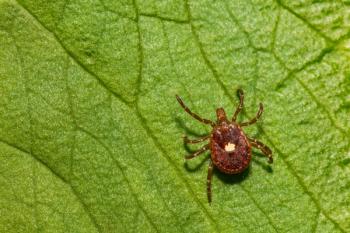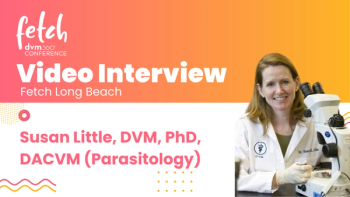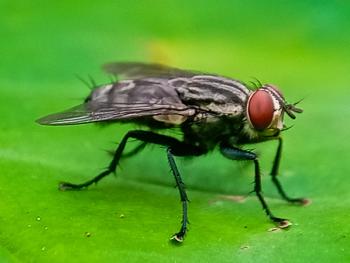
A refresher on Baylisascaris procyonis (Proceedings)
Larva migrans (LM) simply refers to the migration and persistence of helminth larvae in tissues of animals and humans and is separated clinically and pathologically into visceral (VLM), ocular (OLM) neural, and cutaneous larva migrans (CLM). There are many helminth parasites that can cause LM; however, Toxocara and Baylisascaris account for the majority of human cases as well as those in other animals.
Larva migrans (LM) simply refers to the migration and persistence of helminth larvae in tissues of animals and humans and is separated clinically and pathologically into visceral (VLM), ocular (OLM) neural, and cutaneous larva migrans (CLM). There are many helminth parasites that can cause LM; however, Toxocara and Baylisascaris account for the majority of human cases as well as those in other animals. Baylisascaris procyonis, in particular, is well recognized as a cause of clinical LM, affecting a wide variety of wild and domestic species. Best known as a cause of fatal or severe NLM, having been recognized in >130 species of mammals and birds in North America, the parasite can also produce ocular or visceral damage as well. Although human NLM infections are not common, they are usually fatal; thus, B. procyonis has important public health implications.
The life cycle of B. procyonis is direct, although can be indirect with paratenic host involvement. Raccoons are the definitive host, harboring adults in the small intestine. Females produce eggs which are passed in the feces. Naturally infected raccoons can shed an average of 20,000-26,000 B. procyonis eggs per gram; thus, raccoons can shed millions of eggs per day. The eggs reach infectivitiy in as little as 11-14 days under optimal conditions (22-25 C; 100% humidity). Under natural conditions, eggs will reach infectivity more slowly, taking several weeks to months. Eggs can remain infective in the environment for years. Young raccoons probably becom infected by ingesting the infective eggs from their mother's contaminated teats or fur, the contaminated den or raccoon latrines near the den. The larvae hatch from the eggs, enter the mucosa of the small intestine where they develop for several weeks prior to re-emerging into the lumen where they mature. The prepatent period is 50-76 days. In contrast, older raccoons become (re)infected through ingestion of the larvae in paratenic hosts. The larvae develop to adults quickly in the intestinal lumen, reaching patency in 32-38 days. More extensive somatic migration does not appear to occur in raccoons. However, the aggressive somatic larval migration in other animals contributes to the remarkable ability of B. procyonis to produce disease. Most larvae become encapsulated in various internal organs, but, it is the small percentage that migrate to the brain that result in fatal NLM. In these hosts, larvae hatch out of the eggs quickly and penetrate the small intestine. They migrate through the liver to the lungs where they enter the pulmonary veins and are distributed throughout the body. Larvae in visceral and somatic tissue become encapsulated in eosinophilic granulomas where they survive until ingested by a raccoon. Larvae entering the brain produce traumatic damage and inflammation, in part as a result of their massive increase in size – going form ~300 μm when hatching from the egg to 1750 μm at 31 days post-infection. The onset and severity of the resulting CNS disease depends on the number of larvae present and varies with animal species and prior exposure.
Sources of infection include any area contaminated with raccoon feces. Raccoons tend to defecate in localized sites (latrines); thus, these areas are highly contaminated with eggs and are important long-term sources of infection for future generations of animals. Granivorous rodents, birds and other animals can become infected when foraging for undigested seeds present in the raccoon feces. Infection of other animals during investingation of latrine sites or through grooming after becoming contaminated at such a site can also occur. Infection has also been linked to the use of bedding (e.g., straw), feed and enclosures contaminated by wild raccoons or cages and enclosures previously used to house raccoons.
Baylisascaris procyonis occurs wherever raccoons occur. Although the epidemiology of the parasite may differ slightly in urban versus rural environments, the overall presence of the parasite is not affected. Although generally considered to absent from the deep southeastern portion of the US, this parasite has now been documented in areas of Georgia, Florida and Texas. The distribution in the intermountain west is unclear; however, it is known to occur in eastern Colorado and southeastern Wyoming.
Although highly indiscriminent in their ability to infect animals, there is some variation in the susceptibility of various hosts to infection with B. procyonis. Rodents, rabbits, primates, and birds appear to be highly susceptible to NLM caused by B. procyonis. However, no cases of NLM have been reported in opossums even though these animals are routinely exposed through foraging at latrines. Adult domestic livestock or zoo hoofstock have also not been routinely reported with NLM even though they are exposed through contaminated hay. Experimentally, little to no migration was produced in sheep, goats or pigs fed infective eggs and no cases have been documented in cats or raptors that would be expected to eat infected rodents.
Clinically, infected raccoons do not show signs unless heavy infections are associated with intestinal obstruction. If no larvae enter the brain, paratenic hosts generally do not show clinical signs either. The severity and progression of NLM, however, depends on the number of eggs intested, the number of larvae that migrate to the brain, the location within the brain, the extent of damage and inflammation, and the size of the brain. Clinical disease will, therefore, range from acute, rapidly progressive CNS disease with marked clinical signs to mild, slowly progressing CNS disease with sublte clinical signs. Clinical disease can show up 9-10 days post-infection but does not usually manifest until 2-4 weeks poist-infection.
Lately, B. procyonis has become recognized as the common cause of a clinical variant of OLM called large nematode variant diffuse unilateral subacute retinitis (DUSN). It is the most common cause of DUSN in the northern and midwestern US and Canada and can occur in rural and highly urban areas alike. Unlike NLM, which almost exclusively affects infants and toddlers through geophagia (repeated exposure with large numbers of infective eggs), OLM and DUSN usually occurs in otherwise healthy individuals with no obvious exposure, suggesting development of ocular lesions is related to low-level infections. The larva can exist in the eye for weeks to months, or even years.
A change in the biology of B. procyonis my be in progress. Case reports of NLM in dogs show they are susceptible to this disease. However, dogs are being recognized more for developing patent infections, which have been confirmed by recovery of adult worms after anthelmintic treatment. Thus, while many people would not be at risk for exposure to this parasite if confined to the raccoon population, that risk changes with the involvement of dogs. The indiscriminant defecation habits and the strong bond we develop with our pets translates into increased exposure for humans. We currently do not have a clear picture of how many dogs are carrying patent infections; however, it is not confined to any one area of the country having been reported as far east as Prince Edward Island in Canada and as far west as Colorado.
Newsletter
From exam room tips to practice management insights, get trusted veterinary news delivered straight to your inbox—subscribe to dvm360.




